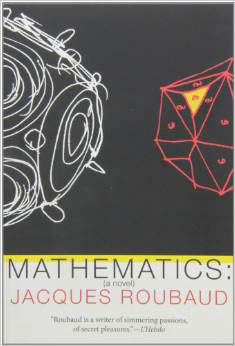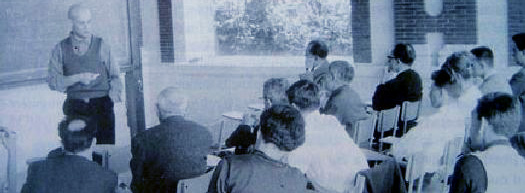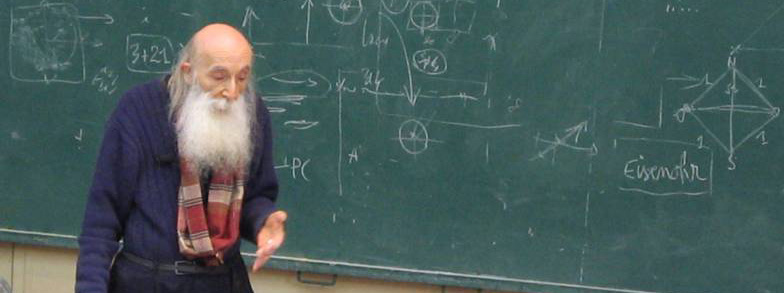At the Bourbaki Seminar in November 1968 the participants were handed the following (premature) announcement of Bourbaki’s death.

The French text can be found at the Canulars Bourbaki, and the English translation below is from Maurice Mashaal’s book Bourbaki, a secret society of mathematicians, page 115.
I’ve underlined a couple of riddles in the text.
———-
The Cantor, Hilbert, and Noether families;
The Cartan, Chevalley, Dieudonne, and Weil families;
The Bruhat, Dixmier, Godement, Samuel, and Schwartz families;
The Cartier, Grothendieck, Malgrange, and Serre families;
The Demazure, Douady, Giraud, and Verdier families;
The Right-Filtering and Strict-Epimorphism families;
Mesdemoiselles Adele and Idele;
regret to announce the death of Monsieur
Respectively their father, brother, son, grandson, great-grandson, and grand-cousin.
He died piously in his home on November 11, 1968 (on the anniversary of great victory) in his home in Nancago.
The burial will take place in the cemetery for Random Functions (metro stations Markov and Goedel) on Saturday, November 23, 1968 at 3 o’clock in the afternoon.
A reception will be held at the bar The Direct Products, at the crossroads of the Projective Resolutions (formerly Koszul square).
Following the wish of the departed, His Eminence the Cardinal Aleph I will hold a mass in Our Lady of Universal Problems in the presence of representatives from all equivalence classes and from all (algebraically closed) fields. The students from l’Ecole Normale Superieure and the Chern classes will observe a minute of silence.
No flowers or wreath products.
“For God is the Alexandrov compactification of the universe.” Groth. IV.22
———-
This announcement is clearly inspired by the faire-part of Betti Bourbaki’s wedding (with Hector Petard), written by Andre Weil and Claude Chabauty in the spring of 1939.
Some years ago I wrote a couple of posts on possible solutions of the riddles contained in that faire-part, a pdf-version can be downloaded as the Bourbaki code. (Note to self: repost some of those and add new material!)
 Whereas the wedding announcement was concocted by members of Bourbaki, this is not the case for this death announcement. It was written by the mathematician and writer Jacques Roubaud, a member of the literary group OuLiPo.
Whereas the wedding announcement was concocted by members of Bourbaki, this is not the case for this death announcement. It was written by the mathematician and writer Jacques Roubaud, a member of the literary group OuLiPo.
In 1997 he wrote the novel ‘Mathematique’ (now available in English translation). In it, he recalls his mathematical years, from his first lecture at the IHP in 1952 till the 70ties. It contains an insiders view on Parisian mathematics in the 50ties and 60ties, dominated largely by Bourbaki, and offers clues to decrypt some of the riddles in the death announcement.
Today, we’ll consider the final one
For God is the Alexandrov compactification of the universe.Groth. IV.22
Can we make sense of the ‘reference’ Groth. IV.22?

Does it refer to EGA IV?
Roubaud’s motif (pardon the expression) for writing the announcement of Bourbaki’s death in 1968 can be read between the lines in his book Mathematics, a novel from which all quotes below are taken.
page 146: “I was invited by Raymond Queneau to join the Oulipo and I met FLL in the fall of 1966. By then, I had reached the end of my passion for Bourbaki, after being one of their most faithful and credulous readers for many years.”
page 73: “The “biography” of that many-headed beast, Bourbaki, is still to be written. It would be a fascinating but arduous task. Here, I shall say only what is strictly necessary to my own entreprise. Having reached his dotage after 1968, “he” is for all intents and purposes now dead.”
By 1968, Bourbaki had become an institution dominating French mathematics and so had to die after the May 1968 revolt.
But, Roubaud had found a new prophet to follow…
page 284: “It was a book of mathematics. It had just been published. It was in a large format, with a blue cover. Its title was Elements of Algebraic Geometry (affectionately and familiarly abbreviated, in French, to EGA). Its author: Grothendieck.
page 285: “For I had so immersed mself in Bourbakism that such a text, the fruit of its final flowering, the monumental work of he who could be considered as Dr. Frankenstein-Bourbaki’s Monster, and which had been drafted according to the group’s inimitable stylistic norms, here applied, in its prose, in a heightened, frenetic way, ran through my mind like honey, no, like nectar, an intellectual ambrosia. Just thinking about it now fills me with stupefaction. I was someone who managed to read EGA with pleasure – worse, with delight. For any normal mathematician today, such an affirmation would seem as perverse as adoring an American soft drink.”
Roubaud was reading EGAs like others would read Nicki French thrillers, one per year:
(1960) : “Éléments de géométrie algébrique: I. Le langage des schémas”
(1961) : “Éléments de géométrie algébrique: II. Étude globale élémentaire de quelques classes de morphismes”
(1963) : “Éléments de géométrie algébrique: III. Étude cohomologique des faisceaux cohérents, Seconde partie”
It was now november 1968, and Roubaud was hoping that another sequel would be published soon. As the last one ended with section IV.21, this new volume would start with IV.22, and, no doubt, contain more divine mathematics…
However, Pieter Belmans objected that it was planned from the outset for EGA4 to consist of 21 chapters, and no more. Surely, Roubaud knew about this…
ADDED october 4th: Pieter has done some further digging on this issue in his post According to Groth IV.22.

Can it refer to SGA IV?
Luckily, there is another option. Grothendieck ran the Séminaire de Géométrie Algébrique du Bois Marie at the IHES from 1962 to 1969.
SGA4 was about “Théorie des topos et cohomologie étale des schémas” (Topos theory and étale cohomology) and ran in 1963–1964. A decade later the notes were published in Springer’s Lecture Notes in Mathematics 269, 270 and 305, 1972/3.
The topic of SGA4 (topos theory) is clearly closer in spirit to the fake biblical quote on the topological nature of God than that of EGA4 which was about the local structure of schemes and their morphisms.
The original notes were published in fascicles by the IHÉS, most of which went through two or three revisions, and were published as the seminar proceeded. So, Roubaud had access to them in the later 60ties.
The original versions, as well as their re-published LaTeX versions can be found here.
Again, we face the problem that there are not enough chapters, only 19 in this case.
Fortunately, we can search the LaTeX-ed version for references to the Alexandroff compactification, and there is just a single one:

This is in the first lecture on Presheaves by Grothendieck and Verdier. More precisely, it is in section 2 (Univers et espèces de structures) of the Appendix, which is labeled
II. Appendice : Univers (by N. Bourbaki (*))

So, the paragraph on the Alexandroff compactification is in SGA IV,II.2, or, if we read 22 as II.2 this might explain Groth. IV.22.
We have found a reference in SGA IV including “Bourbaki”, “the univers” and “Alexandroff compactification”.
But then, who dreamed up this topological definition of God?

Jean-Paul Benzecri
Dieu est le compactifié d’Alexandrof de l’univers.Jean-Paul Benzecri
Jean-Paul Benzécri is a French statistician who has been professor at Université Pierre-et-Marie-Curie in Paris. In the 60ties he was a professor at the university of Rennes where he was a colleague of Roubaud.
 Jacques Roubaud has another book on his reminiscences as a mathematician, Impératif catégorique. Unfortunately, this book is not (yet) translated into English.
Jacques Roubaud has another book on his reminiscences as a mathematician, Impératif catégorique. Unfortunately, this book is not (yet) translated into English.
In section 80, La déesse Fortune ne se montra pas envers moi avare de ses bienfaits, he tells about his years at the University of Rennes where also his friend and topos-theorist Jean Bénabou was at the time. Bénabou and Benzécri knew each other from their student days at the Ecole Normale.
Benzécri had a very strict catholic family background, and in the 50ties he attended the Centre Richelieu des étudiants catholiques.
.
He liked to explain his axiom as follows:
“Of course, God created the univers. But, he created it locally compact and not compact. That it, left on its own, the universe would suffer a serious structural defect which could only be repaired by introducing a point at infinity, which marks the presence of the divine.”
Comments